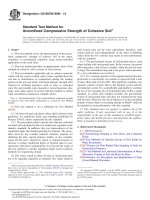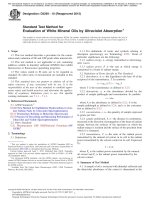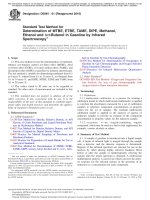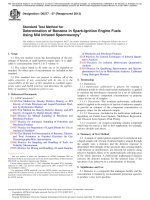ASTM D243/D243M-22 Standard Test Method for Residue of Specified Penetration
Bạn đang xem bản rút gọn của tài liệu. Xem và tải ngay bản đầy đủ của tài liệu tại đây (108.1 KB, 3 trang )
This international standard was developed in accordance with internationally recognized principles on standardization established in the Decision on Principles for the
Development of International Standards, Guides and Recommendations issued by the World Trade Organization Technical Barriers to Trade (TBT) Committee.
Designation: D243/D243M − 22
Standard Test Method for
Residue of Specified Penetration1
This standard is issued under the fixed designation D243/D243M; the number immediately following the designation indicates the year
of original adoption or, in the case of revision, the year of last revision. A number in parentheses indicates the year of last reapproval.
A superscript epsilon (´) indicates an editorial change since the last revision or reapproval.
1. Scope Development of International Standards, Guides and Recom-
mendations issued by the World Trade Organization Technical
1.1 This test method is used to thermally reduce cutback Barriers to Trade (TBT) Committee.
asphalt, a road oil or a semisolid asphalt, having a penetration
greater than 100, to a residue of specified penetration. It is 2. Referenced Documents
primarily used with slow-curing cutback asphalt as specified in
Specification D2026/D2026M. 2.1 ASTM Standards:2
D5/D5M Test Method for Penetration of Bituminous Mate-
1.2 The values stated in either SI units or inch-pound units
are to be regarded separately as standard. The values stated in rials
each system are not necessarily exact equivalents; therefore, to D8 Terminology Relating to Materials for Roads and Pave-
ensure conformance with the standard, each system shall be
used independently of the other, and values from the two ments
systems shall not be combined. D2026/D2026M Specification for Cutback Asphalt (Slow-
1.3 Warning—Mercury has been designated by the United Curing Type)
States Environmental Protection Agency (EPA) and many state D3666 Specification for Minimum Requirements for Agen-
agencies as a hazardous material that can cause central nervous
system, kidney, and liver damage. Mercury, or its vapor, may cies Testing and Inspecting Road and Paving Materials
be hazardous to health and corrosive to materials. Caution D8055 Guide for Selecting an Appropriate Electronic Ther-
should be taken when handling mercury and mercury-
containing products. See the applicable product Material mometer for Replacing Mercury Thermometers in D04
Safety Data Sheet (MSDS) for details and EPA’s website— Road and Paving Standards
additional information. Us- E1 Specification for ASTM Liquid-in-Glass Thermometers
ers should be aware that selling mercury, mercury-containing E230/E230M Specification for Temperature-Electromotive
products, or both, into your state may be prohibited by state Force (emf) Tables for Standardized Thermocouples
law. 2.2 IEC Standards:3
IEC 60584 Thermocouples—Part 3: Extension and Compen-
1.4 The text of this standard references notes and footnotes sating Cables—Tolerances and Identification System
which provide explanatory material. These notes and footnotes
(excluding those in tables and figures) shall not be considered 3. Terminology
as requirements of the standard.
3.1 Definitions of terms used in this practice may be found
1.5 This standard does not purport to address all of the in Terminology D8, determined from common English usage,
safety concerns, if any, associated with its use. It is the or combinations of both.
responsibility of the user of this standard to establish appro-
priate safety, health, and environmental practices and deter- 4. Summary of Test Method
mine the applicability of regulatory limitations prior to use.
4.1 The material to be tested is rapidly heated to 249 °C
1.6 This international standard was developed in accor- [480 °F] and maintained at 249 to 260 °C [480 to 500 °F]
dance with internationally recognized principles on standard- during evaporation of the volatiles. Penetration of the residue is
ization established in the Decision on Principles for the determined and if not within the specified limits, the evapora-
tion procedure is repeated. Change in sample mass is used to
1 This test method is under the jurisdiction of ASTM Committee D04 on Road calculate the percentage of residue having the specified pen-
and Paving Materials and is the direct responsibility of Subcommittee D04.46 on etration.
Durability and Distillation Tests.
2 For referenced ASTM standards, visit the ASTM website, www.astm.org, or
Current edition approved Aug. 1, 2022. Published August 2022. Originally contact ASTM Customer Service at For Annual Book of ASTM
approved in 1926. Last previous edition approved in 2020 as D243/D243M – 20. Standards volume information, refer to the standard’s Document Summary page on
DOI: 10.1520/D0243_D0243M-22. the ASTM website.
3 Available from International Electrotechnical Commission (IEC), 3, rue de
Varembé, 1st floor, P.O. Box 131, CH-1211, Geneva 20, Switzerland, https://
www.iec.ch.
Copyright © ASTM International, 100 Barr Harbor Drive, PO Box C700, West Conshohocken, PA 19428-2959. United States
1
D243/D243M − 22
5. Significance and Use 6.1.3 Hot Plate—The air bath shall be heated upon a
5.1 This test method is used to determine the percentage of suitably mounted hot plate, heated either electrically or by
means of a gas flame. The plate shall be capable of maintaining
residue having a specified penetration at 100 g/5 s at 25 °C the sample continuously at the required temperature, and
[77 °F]. This test method provides a residue for quality control apparatus necessary to fulfill this requirement, such as a
or for use in other tests as desired. rheostat or gas pressure regulator, shall be provided.
NOTE 1—The quality of the results produced by this standard are 6.1.4 Thermometer—A thermometer for measuring the tem-
dependent on the competence of the personnel performing the procedure perature of the sample during evaporation. The thermometer
and the capability, calibration, and maintenance of the equipment used. shall have a measurement temperature range of 200 to 300 °C
Agencies that meet the criteria of Specification D3666 are generally [392 to 572 °F] and an accuracy of at least 2.8 °C [5 °F] and
considered capable of competent and objective testing, sampling, shall be one of the following (see Note 3):
inspection, etc. Users of this standard are cautioned that compliance with
Specification D3666 alone does not completely ensure reliable results. 6.1.4.1 Specification E1 thermometers that meet the tem-
Reliable results depend on many factors; following the suggestions of perature and tolerance range requirements.
Specification D3666 or some similar acceptable guideline provides a
means of evaluating and controlling some of those factors. 6.1.4.2 Type T or Type J (Specification E230/E230M, IEC
60584) thermocouple with a sufficient length of wire that
6. Apparatus allows the meter to be placed away from the heat source and
6.1 The apparatus shall consist of a container, heating bath, with covering that can withstand exposure to the upper
temperature limit, and a sensor-compatible meter that can
hot plate, and thermometric device, with necessary accessory display the temperature to at least one decimal place.
apparatus as follows:
NOTE 3—Guide D8055 provides additional guidance on selecting
6.1.1 Container—The container in which the sample is to be appropriate electronic thermometer alternatives to a mercury-in-glass
tested shall be a flat-bottom, cylindrical seamless tin box, thermometer.
approximately 70 mm in diameter and 45 mm in depth.
6.1.5 A balance, readable to 0.01 g, for determining the
NOTE 2—Containers known in the pharmaceutical industry as seamless mass of the asphalt sample and the mass of the residue.
“ointment boxes” may be obtained in dimensions conforming to the above
requirements. 7. Preparation of Sample
6.1.2 Heating Bath—The heating bath shall be a cast iron air 7.1 Thoroughly stir and agitate the sample as received to
bath, or equivalent, permitting the immersion of the container ensure a uniform mixture before the portion for testing is
to a depth of 32 6 5 mm through an opening 3 6 2 mm larger removed.
in diameter than the container. It shall support the container 6
6 2 mm above the hot plate, and with at least 6.4 mm free air 8. Procedure
space between the sides of the container and of the air bath
below the opening. A suitable air bath is shown in Fig. 1. 8.1 Weigh a 100.00 6 0.1 g sample of the material to be
tested into a tared container, then place the container in the air
FIG. 1 Cast Iron Air Bath bath in position to be heated. Support the probe of the
thermometric device in the sample equidistant from the sides of
the container and with the bottom of the probe neither more
than 6 mm [1⁄4 in.] above nor touching the bottom of the
container. The tip of the probe shall be completely immersed in
the sample throughout the heating. An assembly of the appa-
ratus is shown in Fig. 2.
8.2 Heat the sample as rapidly as possible without foaming
to a temperature of 249 °C [480 °F] and, during the
evaporation, maintain the temperature between 249 and 260 °C
[480 and 500 °F]. Stir the sample with the probe of the
thermometer from time to time to prevent local overheating
and to maintain a homogeneous sample. Stir into the sample all
cakes of hardened asphalt that form at the sides of the
container.
NOTE 4—Certain types of road oil will readily form rings of hard
asphalt at the side of the container. Take great care that this material is
completely stirred into the sample before the penetration of the residue is
determined.
8.3 An experienced operator can judge approximately what
percentage of residue should be obtained to secure the desired
penetration. When it is supposed that the residue will show the
required penetration, return to the container the asphalt on the
probe of the thermometric device that may be readily scraped
off; then remove the container from the air bath and cool and
2
D243/D243M − 22
the container and the surface of the sample, and repeat the
heating and determination of penetration as before. Ordinarily,
a residue shall be considered as satisfactorily obtained when its
penetration is within 15 units of that desired, and its mass
percentage of the original sample shall be calculated. When it
is necessary to determine more precisely the percentage of
residue having the specified penetration, such a percentage
shall be calculated by interpolation between percentages of two
residues, one having a penetration greater and one having a
penetration lower than that specified.
9. Report
9.1 Report the results as follows:
9.1.1 Percentage of residue of——penetration
(determined——), stating first the specified penetration, and
second, the penetration actually determined for the sample
tested or calculated by interpolation.
FIG. 2 Assembly of Apparatus 10. Precision and Bias
determine the mass of the residue. Determine the penetration of 10.1 With care and proper attention to details, duplicate
the residue in accordance with Test Method D5/D5M, except determinations by this test method should not differ from each
use the container in which evaporation was conducted, as other by more than 1.0 % with the same operator, nor more
specified in this test method, instead of using the smaller than 2.5 % between different laboratories.
container specified in Test Method D5/D5M.
10.2 Bias—The procedure in this test method has no bias
8.4 It frequently is necessary to make several trials before a because the property being measured is defined only in terms
residue of the required penetration is obtained. If it is deter- of this test method.
mined to be greater than that required, remove all water from
11. Keywords
11.1 asphalt; cutback; penetration; residue; road oil
ASTM International takes no position respecting the validity of any patent rights asserted in connection with any item mentioned
in this standard. Users of this standard are expressly advised that determination of the validity of any such patent rights, and the risk
of infringement of such rights, are entirely their own responsibility.
This standard is subject to revision at any time by the responsible technical committee and must be reviewed every five years and
if not revised, either reapproved or withdrawn. Your comments are invited either for revision of this standard or for additional standards
and should be addressed to ASTM International Headquarters. Your comments will receive careful consideration at a meeting of the
responsible technical committee, which you may attend. If you feel that your comments have not received a fair hearing you should
make your views known to the ASTM Committee on Standards, at the address shown below.
This standard is copyrighted by ASTM International, 100 Barr Harbor Drive, PO Box C700, West Conshohocken, PA 19428-2959,
United States. Individual reprints (single or multiple copies) of this standard may be obtained by contacting ASTM at the above
address or at 610-832-9585 (phone), 610-832-9555 (fax), or (e-mail); or through the ASTM website
(www.astm.org). Permission rights to photocopy the standard may also be secured from the Copyright Clearance Center, 222
Rosewood Drive, Danvers, MA 01923, Tel: (978) 646-2600; />
3









